

|
| Home Previous Next | |
|
|
|
[Click on any photo to enlarge it] Day Two - Northwest of BeijingThe Great Wall and The Ming TombsWe were up at 6:00A.M., at breakfast by 6:30 A.M., and on the bus a little before 8:00A.M.. I have a feeling this is going to be a standard routine for our trip. But we had 2 hours to drive so best be on the road. Besides, this would be my first glimpse of life in the country. The Great Wall (Chángchéng)Parts of the Great Wall were begun as early as the 7th century B.C. At that time China consisted of many states and these states built walls as protection from one another. There were seven primary states: Qin, Qi, Chu, Yan, Han, Zhao, and Wei. 
Qin Shi Huang (260 - 210 B.C.) was born Ying Zheng - a Prince of the state of Qin. At the age of 13 his father died and he was pronounced King Zheng. A chancellor ruled in his stead until he came of age. King Zheng and his troops began to take over different states. By 230 B.C. there were only 3 remaining warring states. The first state to fall was Han in 230 B.C.. The King and his armies conquered the state of Zhao in 228 B.C., the northern country of Yan in 226 B.C., the small state of Wei in 225 B.C., and the largest state and greatest challenge, Chu, in 223 B.C.. By 221 B.C. all of China was unified under one powerful ruler. He proclaimed himself the First Emperor (Shî Huángdì) and took the name Qin Shi Huang (meaning "first Emperor of Qin"). In his efforts to continue to unify China and to avoid the political chaos that once existed under the Warring States, he began by abolishing feudalism. He standardized the units of weights and measurements. He standardized the currency across China. He built an extensive system of roads and canals to link the provinces so as to improve trade between them. He also unified the language. This new script was standardized among all the conquered regions and thus formed one language throughout China. He was able to expand the Chinese state by adding the southern lands of Hunan and Guangdong, and also conquered lands in central Asia. He made broad political and economic reforms in order to standardize the various practices of all the earlier Chinese states. Qin Shi Huang is also responsible for the Terracotta Army in Xi'an. One of the first projects he accomplished after becoming King was to have built his own tomb. The tomb has yet to be opened and there is evidence to suggest that it remains intact after all of these years. The tomb is described as including “replicas of palaces and scenic towers, ‘rare utensils and wonderful objects,’ 100 rivers made with mercury, representations of ‘the heavenly bodies’, and crossbows rigged to shoot anyone who tried to break in.” The Terracotta Army guards the tomb. 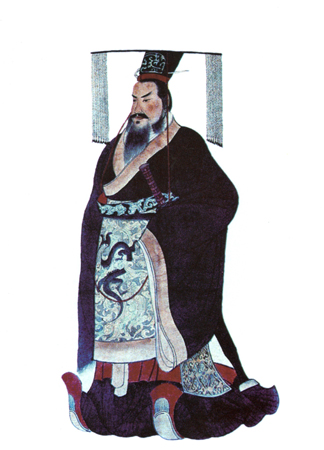
Qin Shi Huang
Now that all of the Warring States had been unified into one land, it became necessary to protect all of the northern borders. Walls already existed in some of the areas, so Qin Shi Huang ordered the walls to be connected into one very long wall. In fact, that is what the name Chángchéng means in Chinese - The Long Wall. There are no records that remain to tell us just how long Qin Shi Huang's wall was at that time, but today the wall stretches for more than 5,000 miles. In fact there are recent accounts which take old sections of the wall into account that now estimate the wall to be over 13,000 miles long. A very long wall indeed! The area of the wall where we were taken is called Badaling and is about 2 hours northwest of Beijing. Once we got out of Beijing and into the mountains we started to see other sections of the wall. 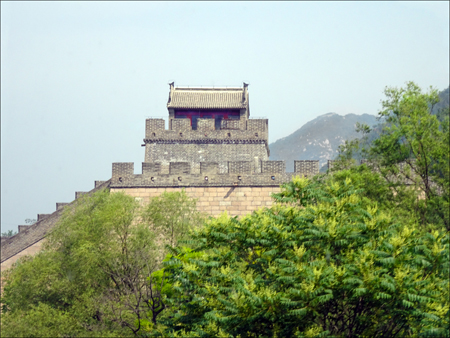
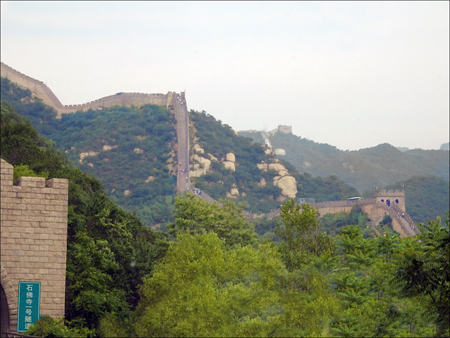

The Badaling portion of the wall was built during the Ming Dynasty in 1505. It has undergone extensive renovation and it opened to the public in 1957. This is the most visited section of the Great Wall of China with over a million visitors every year. I certainly believe that because there were thousands of people there when we were there. The bus had to park a small distance from the entrance. I rolled Reuben up to the entrance but then he had to walk the rest of the way. Zhang Lu, our guide, took the wheelchair back to the restaurant where we were to meet after. There were many small shops all around the entrance to the wall. I would have liked to have seen some of them, but we wanted to spend most of our time on the wall. 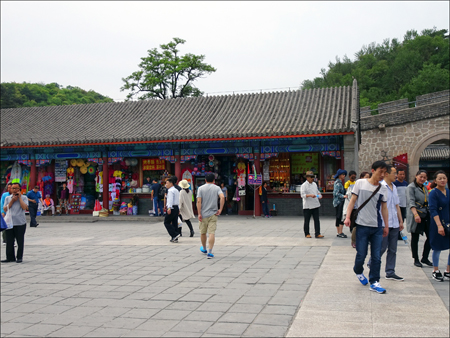


There was a police guard house in the square. 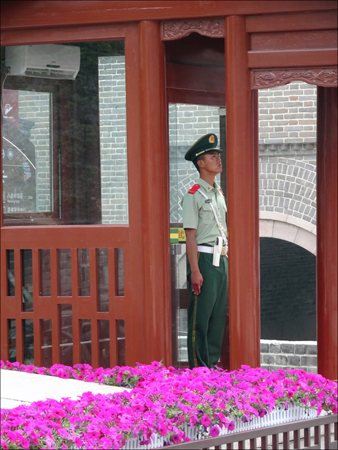
We climbed the many stairs to the top of the wall. To the left was the steeper portion of the wall and to the right was still uphill, but not as steep. We went to the right. 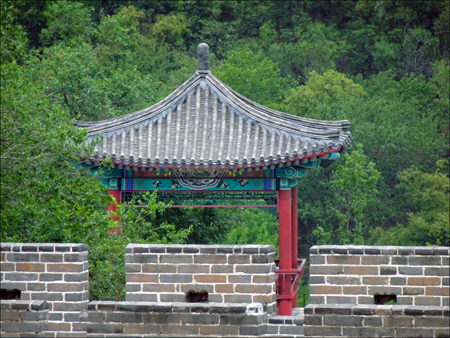
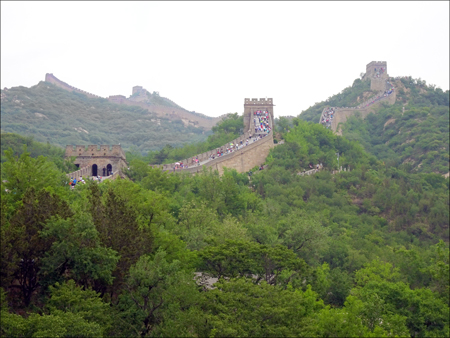
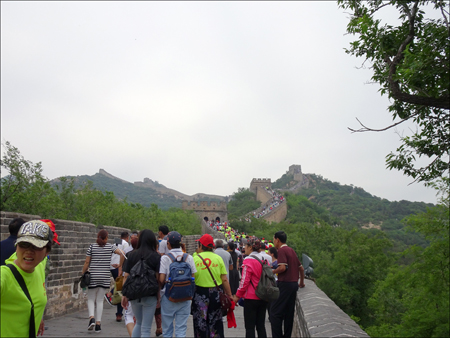
It was amazing but so terribly crowded. Reuben walked almost all the way to the 2nd turret which was just great. 
All the Chinese people turned around to smile and give him a thumbs up. Many of them asked how old he was. I told them 88. And a great many wanted their photo taken with him. Our guide said it was because the Chinese people have a lot of reverence for older people. 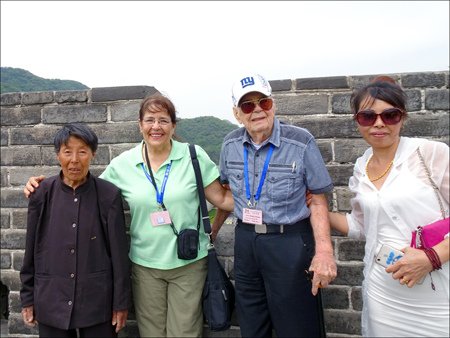
Coming down was extremely difficult for both of us. It was difficult with the crowds, but walking downhill and trying to go down the uneven and unlevel steps was not easy. But we made it. Reuben waited at the bottom while I went back to the restaurant for the wheelchair. Then we all met at the restaurant for lunch. This time it was a large buffet with many interesting choices. Click here for Postcards of The Great Wall The Ming TombsWe had to drive about 45 minutes to get from Badaling to the Ming Tombs. We passed more sections of the Great Wall. It was beautiful driving through the mountains. 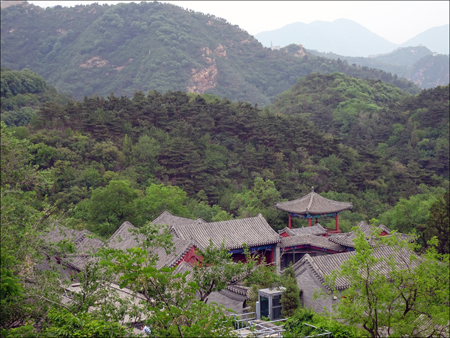
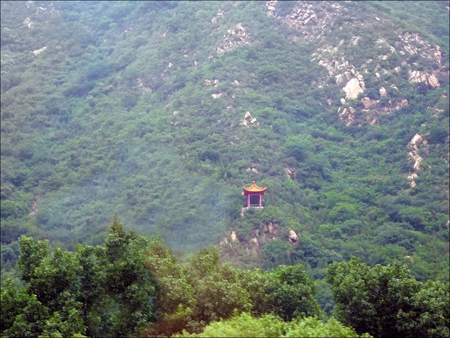

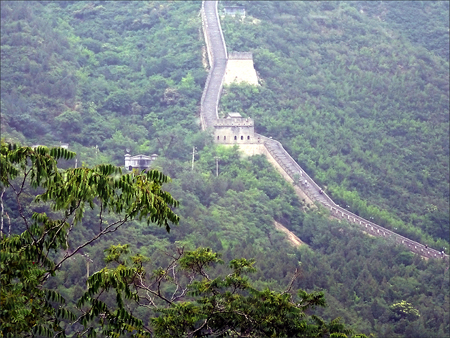
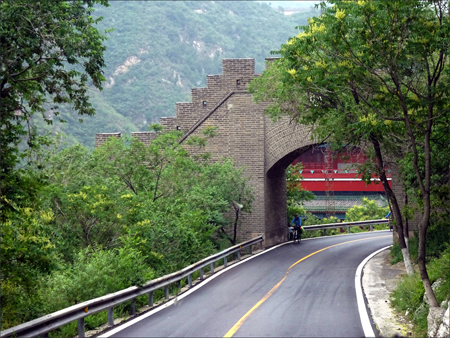

The Ming Dynasty ruled China for 276 years (1368-1644) and was one of the longest and most stable periods in China's history. During the Ming Dynasty there were many large civil engineering projects. The Great Wall which had been unified by the Qin Dynasty was reinforced with brick and stone. The Grand Canal was rebuilt and the resulting trade helped the economy to flourish. The Forbidden City and the Temple of Heaven were built during this reign. All forms of art flourished - literature, painting, music, poetry, and porcelain. The Civil Service was introduced and in order to attain a position, people had to pass extremely difficult exams, which put very talented people in government positions. A navy and army were constructed of around a million troops. China became an international power by establishing trade and diplomacy with other countries. The Ming Dynasty Tombs are a memorial site where 13 Emperors, 23 Empresses and 1 Concubine are buried. Built at the foot of Tianshou Mountain, the 13 individual tombs stretch out in a fan shape except for Xiling Tomb. The design follows the principles of Feng Shui and great attention was given to the harmony and unity with nature. At the present time only 3 of the tombs are open to the public: Changling Tomb, Dingling Tomb, and Zhaoling Tomb. 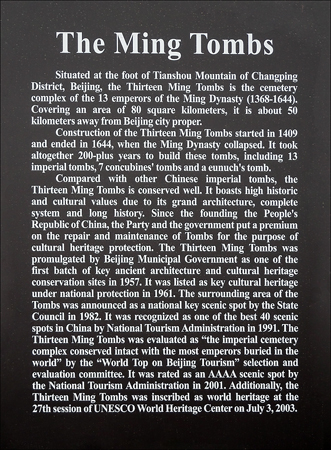
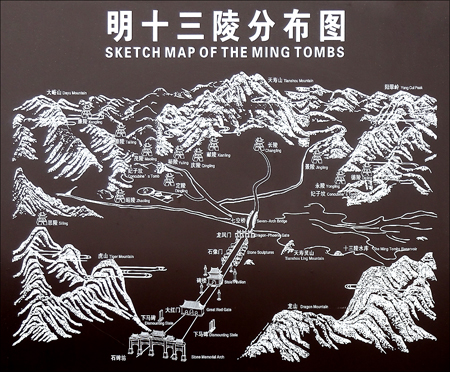
We were taken to see Changling Tomb - the largest of all the tombs. This is the tomb of the Yongle Emperor and his Empress Xu. He is the man who built the Forbidden City and the Temple of Heaven and was the driving force behind so many of the accomplishments of the Ming Dynasty. Changling tomb covers about 30 acres. 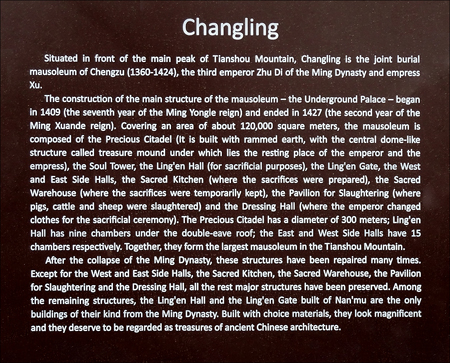
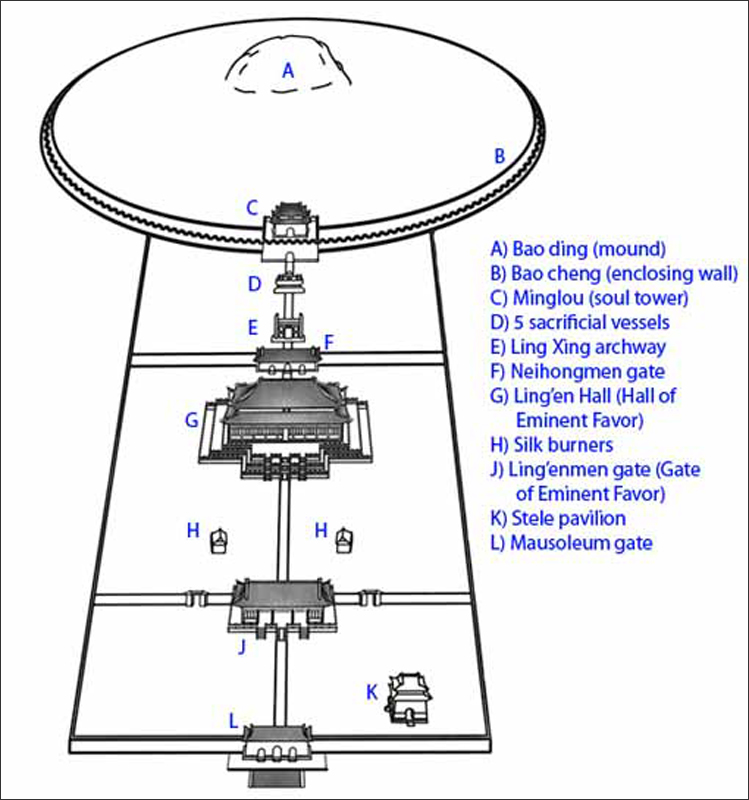
Changling Tomb is in a beautiful setting with many trees around it, and landscaped with lovely flowers. 
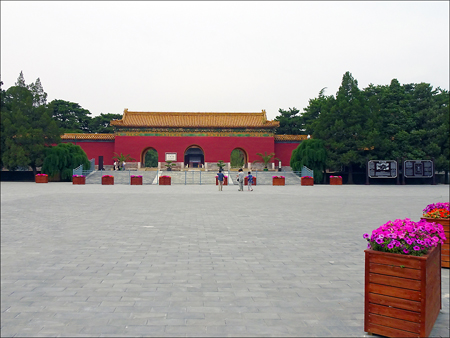
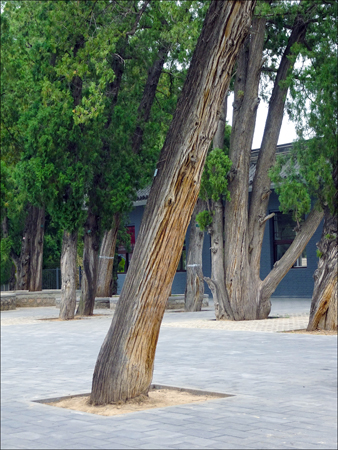

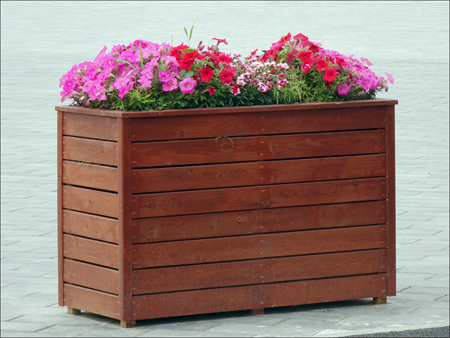
After going through the entrance gate there were two interesting small buildings on either side. They are both silk burning stoves. I'm not sure how or why they were used. 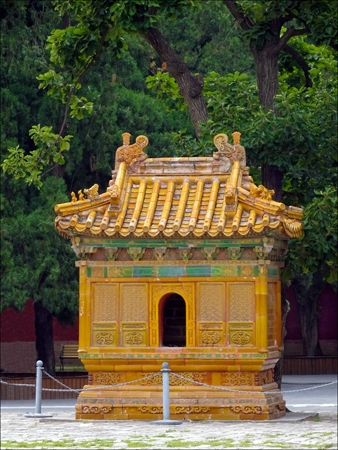

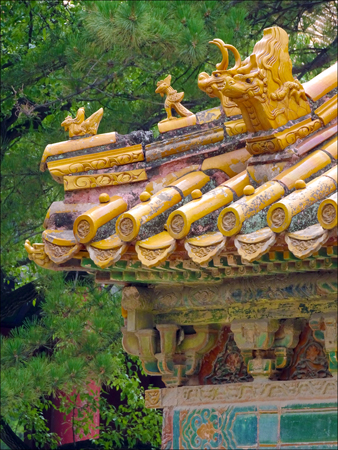
The next building is the Ling'en Gate (means Blessing and Grace Gate). We didn't go through it because of all the stairs. We went around the outside. 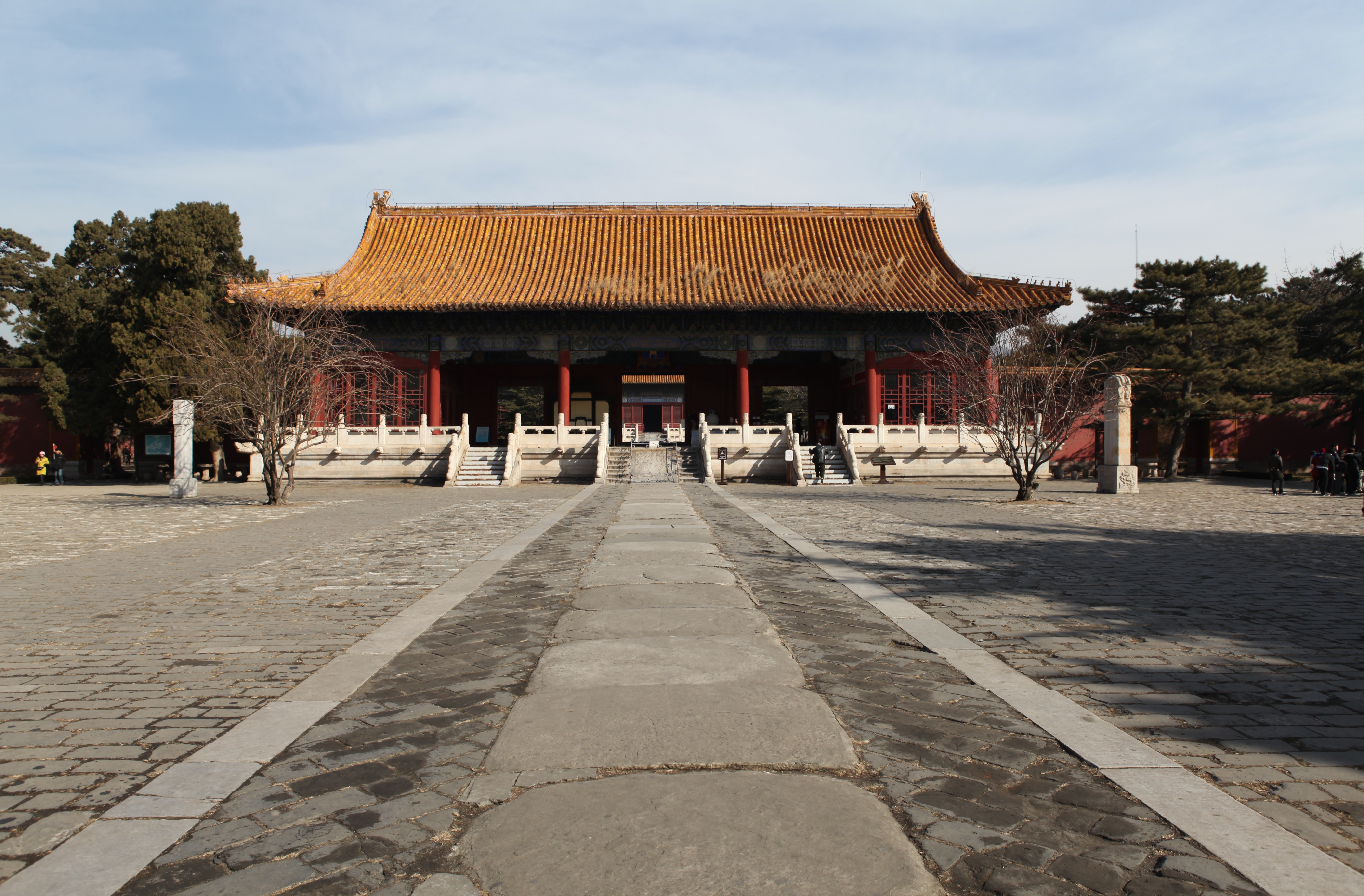
The following building is the large Ling'en Hall, or the Blessing and Grace Palace. It is the place for making sacrifices to the Emperor and Empress. It is the only preserved tomb palace from the Ming Dynasty. It covers half an acre and is made of camphor wood sitting atop a three-tiered pedestal of white marble. 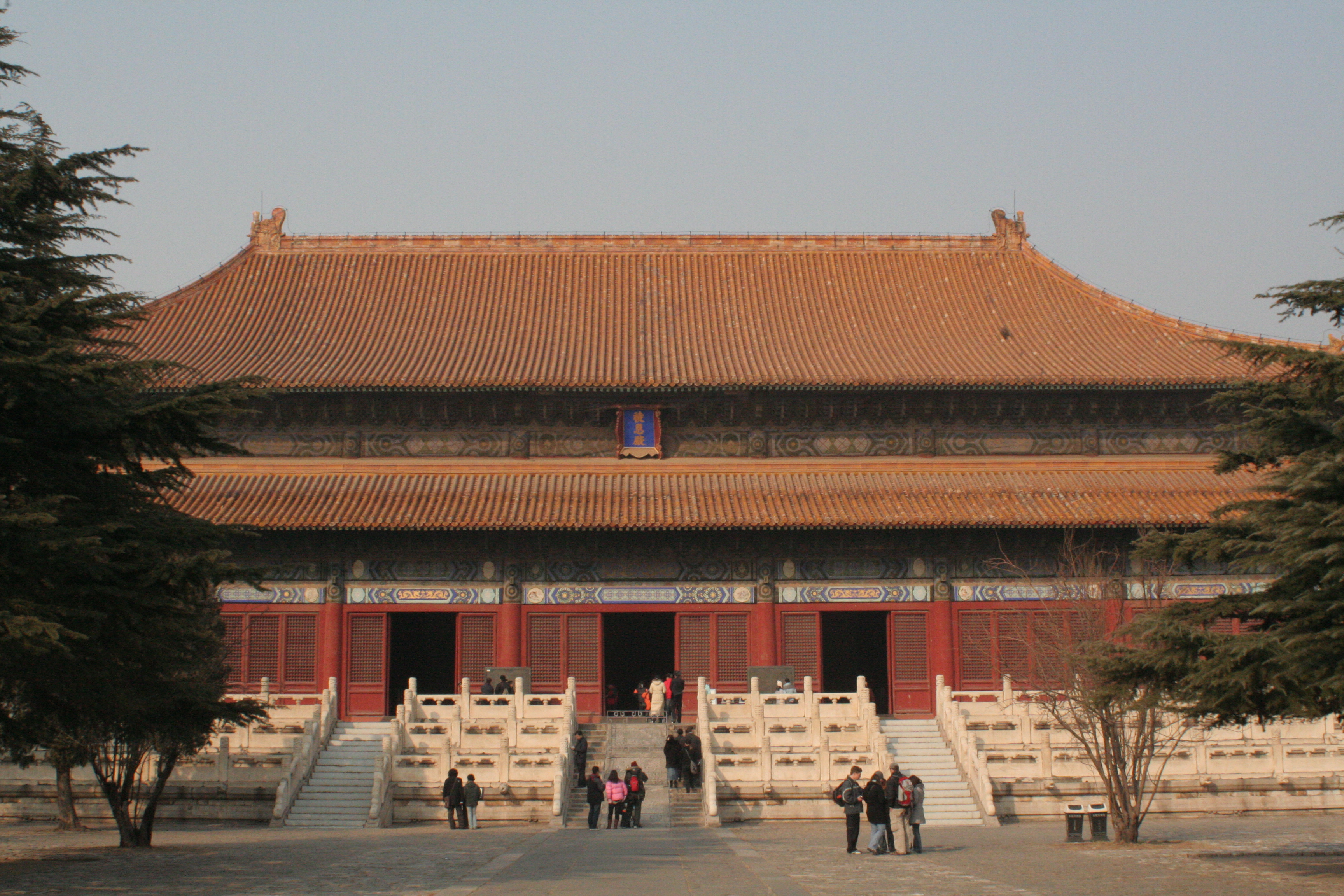
There are 16 solid camphor posts supporting the ceiling, the thickest one is 3 feet in diameter at the bottom. In the center is a large bronze sculpture of Emperor Zhu Di - the Yongle Emperor. The ceiling is highly decorated. 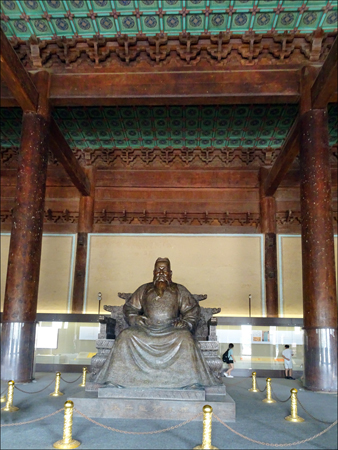
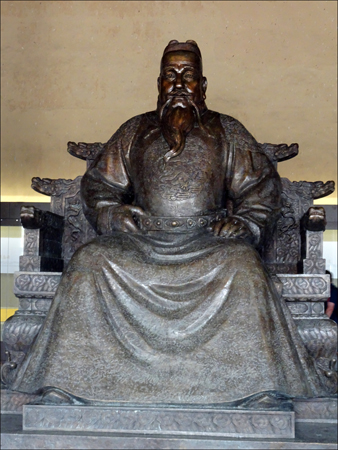

Also on display inside the Ling'en Hall are many objects and photos showing the great achievements of the Emperor. There is a portrait of Emperor Zhu Di and another of the Empress Xu.
We chose not to go further back within the tomb because it was so large and we had all of the cobblestones to roll across going back. It makes for very slow going. As we left the Ming Tombs area, we passed a large statue of Li Zicheng. He overthrew the Ming Dynasty in 1644 and became Emperor. Thus began the Shun Dynasty. 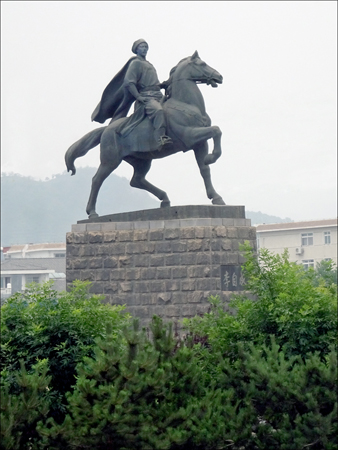
Click here for Postcards of The Ming Tombs Tea CeremonyWe had a nice drive back to Beijing. Our next stop was a teahouse where they performed a tea ceremony for us. The ceremony was on the second floor and there was no elevator. So they arrange for Reuben and I to have a private ceremony downstairs. Very nice. They told us about many kinds of Chinese teas. Unlike teas that are in tea bags that we get back in the states, these loose leaf teas are very pure. Tea bags, it seems, have additives in them such as sawdust to help keep the tea leaves dry, and are loaded with things like pesticides, toxins, artificial ingredients, added flavors and GMOs. And tea bags themselves are not safe either. The silky plastic ones can leach out polymers when exposed to boiling water. The paper ones are quite often treated and it turns out that these treatments can become carcinogenic. Here's a chart I found online about some of the more popular tea brands. If you'd like to read more, click here. 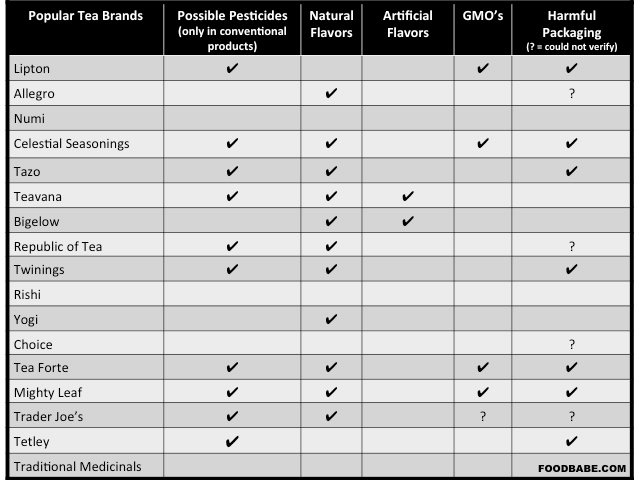
As we found out, the Chinese teas are free of these things. And because they have no chemicals or caffeine, it means that you can infuse them 5-10 times without any bitterness or loss of flavor. She made about 10 different teas for us. They were all delicious. 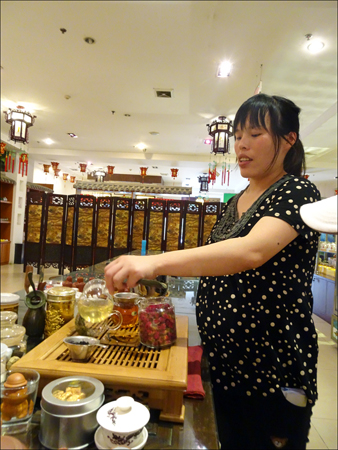
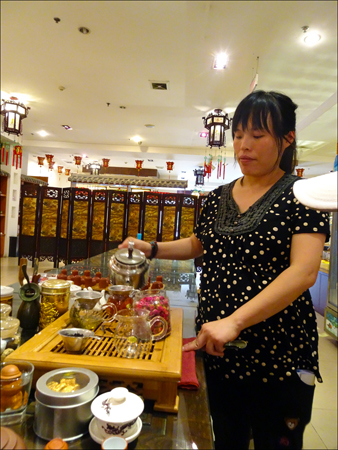
Some were made from flowers and the whole buds were still there. Some were leaves. Some were dried petals. And some were combinations. 
I really wanted to buy many teas to bring home, but this was only my second day on the trip and I didn't want to start filling up my suitcase just yet. So I only bought some ginseng tea. Of course they had many other teas to sell. 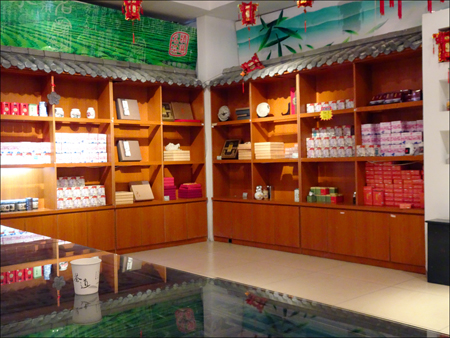
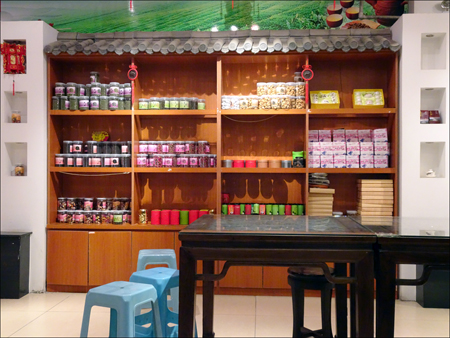
They also sold teapots, of course. There were so many beautiful ones. I wish now that I had bought one. They say that the best teapot is one that is unglazed ceramic. They say that once you buy a teapot that you "raise" it - like bringing up a child. In China you buy a teapot for certain kinds of tea. You would only make those teas in that pot. You never wash it with soap, only rinse. In time the teapot will take on a beautiful patina because of the years of making tea in it. Every tea will leave its mark in a different way, that's why you don't mix teas in the same pot. Old and well-used teapots are highly respected in China and they can command very high prices. 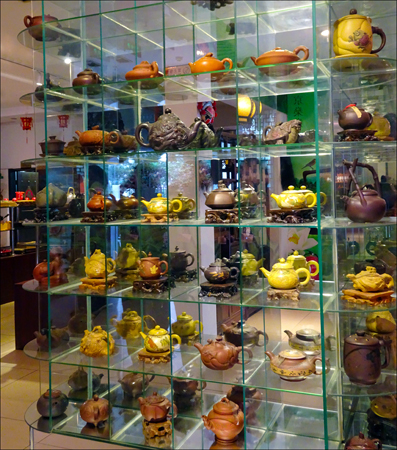
Peking Roast DuckBy now it was time to head off for dinner. Tonight is supposed to be our special meal of Peking Duck. This dish dates all the way back to the Yuan Dynasty (1271-1368) and was served at the Imperial Court. The earliest known restaurant in Beijing to serve Peking Duck was Bianyifang Restaurant, which was open during the Jiajing reign (1522-1566). This duck is prepared by first separating the skin from the fat by pumping air in between. It is then hung in the open air to dry while being basted with a sweet maltose. Then it is baked until the skin is crispy and the flesh succulent. The duck is then thinly sliced into 120 pieces and served. Each person puts their piece of duck on a thin pancake and top it with thinly slivered scallions, cucumbers, and a sweet bean sauce. It is then rolled up and eaten. Twenty years ago when I was in Hong Kong we went to a very fine restaurant for Peking Duck. It was amazing and totally delicious. However, in this restaurant we were served most of the same Chinese dishes we had had in previous meals. By the time the chef came around with the duck and its trimmings we were full. And, to be honest, it was nothing like I remember it, but it was still quite good. And we had a good time. 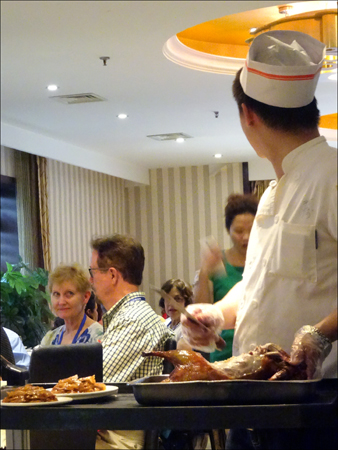
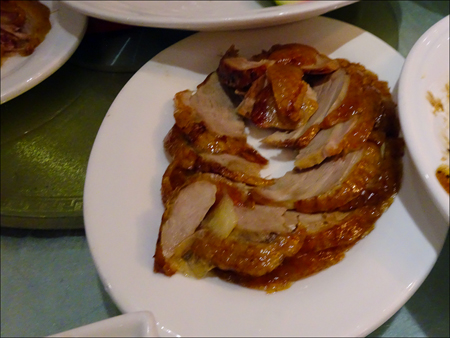
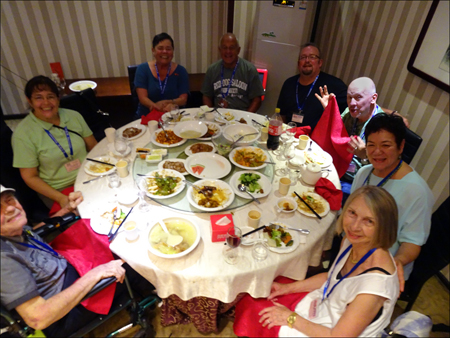
Finally it was time to go back to the hotel and pack, because tomorrow we leave Beijing. Once we got back to the hotel I got Reuben settled in the room and went to help Suzanne, another girl on our tour, to find batteries for her camera. We ended up having to go to several places, but finally found a 7-11-type store and got them. When I got back to the room, Reuben said someone called to say they had his jacket. It seemed rather odd. I couldn't get a dial tone on our phone in the room so I went to the lobby. I called our tour guide, Zhang Lu, to ask his advice. He said he thought that it was someone trying to get me to meet them someplace and wanted money, and he advised me not to go. He said that he had called the taxi company twice and they said no jacket had ever turned up. So this must be some kind of scam. About that time I heard the desk clerk talking on the telephone and spelling out my name. I realized he had a phone call for me. It turned out to be my friend Mr. Shu. He said that the taxi driver did return with the cake and the jacket and he had them at his house! It was already after 9 P.M. and I was frantically thinking of ways I could get Reuben's jacket delivered or sent or something. I finally realized the only thing to do was take a taxi back out to Mr. Shu's home and pick it up myself. So the concierge ordered one for me. I don't know what was going on in Beijing this night, but it was at least 30 minutes before a taxi showed up. And at least another 30 minutes before we got out of the city and onto the motorway. I was not too happy about that because we had to be up early again the next day. But such is life. And I also realized that this must be karma to arrange for Mr. Shu and I to get to see one another one more time. Our time was so short after all of these years. So it was wonderful to get to visit again, if even for a short time. Unfortunately, his daughter Shu Shu had already left to go home, so I didn't get to see her again. But, I got the coat. The next morning no one in the group could believe the story. Someone said that it must have been the good Qi from the ancient trees! Maybe so! |
|
| Home Previous Next | |
|
|

|
|
|
Irma Hale E-mail: Copyright © Irma Hale. All
Rights Reserved. Free counters provided by Vendio |